Ellis,J. Pressure transients in water engineering, A guide to analysis and interpretation of behaviour
Подождите немного. Документ загружается.


acceptable. It is possible for the damping mechanism to have a two-
stage closure. For instance a relatively rapid closure may be adopted
between 100% open to 30% open in say 5 s and the remaining closure
from 30% open to shut taking 10 s. Reopening of the valve requires a
hydraulic actuator.
21.8 Nozzle valves
A second group of check valves involves axial movement of the valve
door rather than the rotational movement discussed hitherto. Three
examples are shown in Fig. 21.9. Many of these valves fall into the
category of nozzle valves. An axial spring mounted behind the door is
compressed by the forward flow of water manifest as a differential hydro-
dynamic pressure force across the valve door. When flow decelerates
the hydrodynamic force diminishes, allowing the spring to expand
422
(b) Nozzle check valve
e.
g
. SOCLA type 402
(a) Demag type DRV-Z nozzle check valve
+ +
Open
Spring
Open
Shut
ShutLinear spring
(c) Alstom Clasar check valve
Open Shut
Spring
+
Fig. 21.9. Valves with axial springs
Pressure transients in water engineering
and pushing the door on to its seat. The distance which the valve door
has to travel is generally small, allowing a relatively prompt closure to be
achieved.
Closure performance is governed by the equation:
X
axial forces ¼ 0
These pertinent forces are:
Hydrodynamic force ¼
ð
p dA
Friction force ¼ R
Inertial force ¼ W
s
=g dv=dt
Buoyant weight ¼W
s
(þ sign in upwards flow and sign in down-
wards flow)
Spring force ¼ x (where is in N/mm and x is movement in mm)
Good closure performance can be achieved with a short stroke and a
small disk mass. An adjustable spring force gives flexibility in applica-
tion of the valve.
As with other internal spring-assisted valves it is deemed inadvisable
to use this type of valve when the liquid carried contains material which
may become entangled with the spring and impede closure. Some of
these valves, such as the Demag nozzle type (Fig. 21.9a), have a stream-
lined body designed to maximise recovery of kinetic energy developed
as flow passes through the throat of the valve. This streamlining
tends to produce a longer valve than other types which do not recover
the same amount of energy. There has to be a trade-off between energy
savings in the case of the more expensive longer-body type for which
increased space must be reserved within a pumping station and a
cheaper valve in which greater head loss occurs but which is shorter
and does not require the same amount of space. The globe-shaped
version is an example of a shorter body type (Fig. 21.9b), with a door
travel of about DN/4.
The Alstom Clasar wafer type illustrated in Fig. 21.9c, is a variation
on the axial movement valve. The valve door comprises a set of
concentric streamlined rings having a central shaft and axial spring.
When closed, these moving rings seal against a set of fixed rings. On
opening, the spring is pulled into tension by the hydrodynamic force
acting on the set of moving rings. Travel of the moving rings is typically
<DN/10 and valve length is <DN/2. When a pump is tripped and flow
423
Check valve characteristics
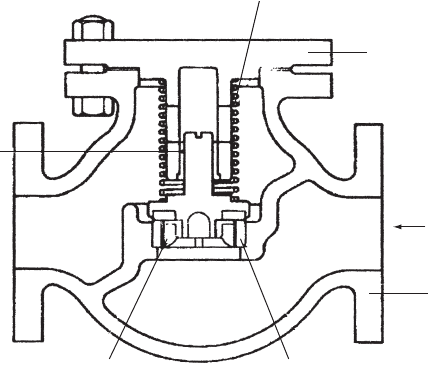
decelerates, the hydrodynamic force decreases allowing the spring to
pull the moving rings onto their seat. This valve has many advantages
including having a very good closure performance. Being a wafer-type
valve it is short, thus taking up minimal space. As with other valves,
having relatively constricted flow passages and internal springs, the
valve is more suited to relatively clean liquids rather than sewage appli-
cations. Head drop through the valve when fully open is 2:2V
2
=ð2gÞ.
One other example of a valve employing a linear spring for closure is
the lift-disk shown in Fig. 21.10. The more complicated flow passage
through the valve tends to yield a greater head loss than other patterns.
A very good closure performance is achieved, making this valve suitable
for applications such as in high-rise buildings.
There remain other patterns of check valve in which the closure
element is more unusual.
21.9 Moving ball
A further example of a free-acting type is the moving ball pattern in
which a spherical door is pushed along guides by flow passing through
the valve, thus moving the door from its seat (Fig. 21.11). When
flow ceases, the ball rolls back down the guides to seal the valve.
This valve is suited to sewage applications but does not have a good
closure performance. Its use should preferably be restricted to systems
424
+ Flow direction
SeatDisc
Guide bush
Spring
Cover
Body
Fig. 21.10. Lift-disk check valve
Pressure transients in water engineering
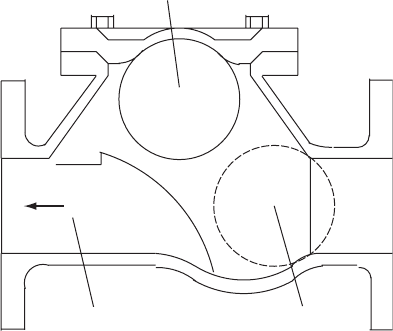
where flow deceleration is relatively low at the valve, for instance solo
duty pump installations with modest static lift, so that the system-
imposed dV=dt is small. Advantages are that the ball is self-cleaning
with virtually no risk of blockage. This valve pattern finds application
in sewage systems and other areas such as mine drainage.
21.10 Sleeve or duckbill valve
Many of the free-acting valves considered, such as the swing check
valve, develop the necessary force to decelerate a reversed flow by
mobilising the resistance offered by the valve and its surrounding
pipework and supports. Since these are generally relatively rigid, the
deceleration force is usually developed with only a small elastic defor-
mation of the valve and adjoining pipes. The reversed velocity is
reduced to zero in a very short time after the door meets its seat. The
sleeve valve represents a departure from this type of behaviour. Suitable
for both horizontal and vertical upward flow, this valve contains no
obvious damping mechanism. A rubber sleeve is reinforced either
internally using fabric Nylon ply or possibly externally with longitudinal
stiff rubber strips. These additions act in the same manner as springs. At
design flow the sleeve is opened to give a circular section and as flow
decreases then these stiffening springs pull the rubber sleeve back to
a closed position (Fig. 21.12). The force required to resist and to
decelerate a reversed velocity is achieved by the subsequent deforma-
tion of the sleeve following closure. Up until the moment of initial
425
+
Valve open
Normal direction of flow Valve closed
Fig. 21.11. Moving ball check valve
Check valve characteristics
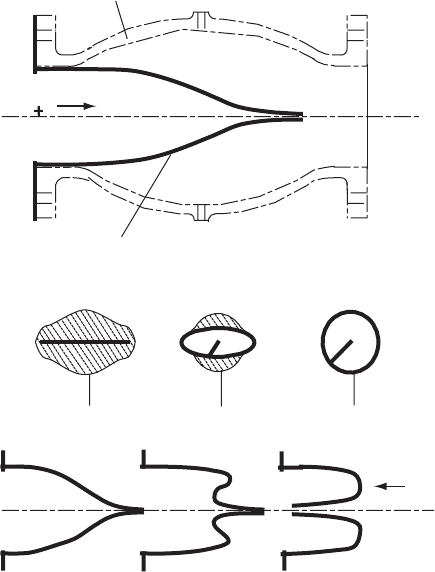
closure the valve acts much as a free-acting valve in that it does not
greatly affect the rate of flow change. Subsequent to initial closure,
deformation of the sleeve over a significant time produces a more
gradual flow deceleration than say a swing-check valve, and this part
of the process is more akin to that of a damped valve.
This valve is suitable for lines conveying slurry, sludge, lime, chemical
slurries, paper plant waste and raw sewage, with the flexibility of the
rubber sleeve allowing the valve to seal even in the presence of
gravel. When installed in appropriate conditions, the valve will produce
a quiet closure. If subject to excessive transient differential pressure
across the sleeve, the possibility of damage exists through the rubber
sleeve being pushed inside out or ‘inverted’. To prevent damage it is
essential to choose a valve having the ability to resist the maximum
differential pressure likely to be experienced across the valve. A range
426
(b) Flow reversed(a) Valve closed (c) Sleeve inverted
Cast iron or aluminium body
Neoprene, pure rubber, hypalon, EPT or Buna-N
sleeve reinforced with nylon fabric
Part open Fully openClosed
Direction of
reversed flow
Fig. 21.12. Sleeve or duckbill valve
Pressure transients in water engineering
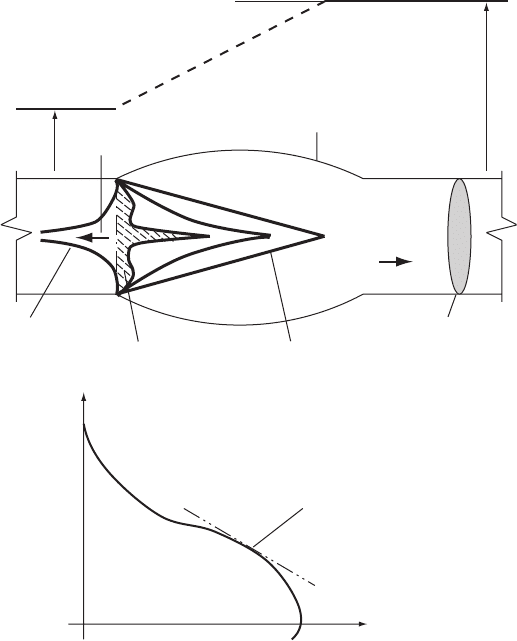
of reinforcement options is available, from very soft where inversion will
occur at differential heads 6 mWG, to much stiffer forms with
maximum allowable differential pressure head 100 mWG. As far as
predicting behaviour of this type of valve is concerned, although the
valve is free-acting in the sense that it does not have any damping
mechanism, nonetheless the response of the valve during closure has
an influence upon the hydraulic transient event and thus upon the
maximum heads developed across the valve. The valve should ideally
be modelled as a part of the pipeline system.
The following represents an attempt to model the hydraulic transient
behaviour of a sleeve valve within a pipeline system.
With reference to Fig. 21.13, after the valve has initially closed, as
differential pressure changes so the deformed shape of the sleeve will
427
+
dVol
in
/dDH = rate of change of inlet volume
with differential head across valve
Piezometric line
H
u/s
H
d/s
Reversed flow
Valve body
V = velocity
Pipe area = A
Check sleeve
Inverted sleeve
Inlet volume = Vol
in
Vol
in
DH = H
d/s
– H
u/s
Fig. 21.13. Definition sketch for sleeve valve analysis
Check valve characteristics
alter and with it the volume of liquid on the inlet and outlet sides of the
sleeve. The total volume within the valve body remains constant — that
is, inlet volume þoutlet volume ¼constant. It is necessary to know the
relationship between inlet or outlet volume and differential head. This
information can be obtained from, for example, experimental measure-
ment or finite-element analysis of the sleeve under load. Given the
relationship between inlet volume and differential head and ignoring
inertial effects within the sleeve, then over a time increment of the
analysis:
VA ¼ dVol
in
=dt ¼ dVol
in
=d H d H=dt ð21:1Þ
where Vol
in
is the inlet volume, H is the differential head ¼
H
d=s
H
u=s
, V is the velocity and A is area of flow. Digitising the
relationsh ip between inlet volume and differential head (Fig. 21.13),
and interpolating using initial values and averaging over the time
increment t then with dVol
in
=d H Vol
in
=ðHÞ¼gradient of
Vol
in
=H curve and suffix ‘o’ denoting conditions at the start of the
time increment:
ðV þ V
o
ÞA=2 ¼ gradient ½H
d=s
H
u=s
ðH
d=so
H
u=so
Þ=t
From the characteristic paths:
Jþ¼V þ g=aH
u=s
and J¼V g=aH
d=s
or
H
d=s
H
u=s
¼ a=g½2V ðJþþJÞ
Writing, constant ¼ 2a=g gradient=ðA tÞ and rearranging then:
V ¼ constant½JþþJþg=aðH
d=so
H
u=so
Þ=ð2 constant 1ÞV
o
ð21:2Þ
Corresponding values of H
u=s
and H
d=s
are obtained by substituting the
value of V into the quasi-invariant equations.
Prior to initial sleeve closure and subsequent to any sleeve inversion,
the relationship between differential head and velocity should be
expressed in the form:
H ¼ K
L
V
2
=ð2gÞ
where K
L
is a loss coefficient. The sleeve may become inverted if the
differential pressure exceeds a maximum permitted limit. Transient
analysis can be used to establish this limit for any system so that an
appropriate sleeve can be used.
428
Pressure transients in water engineering
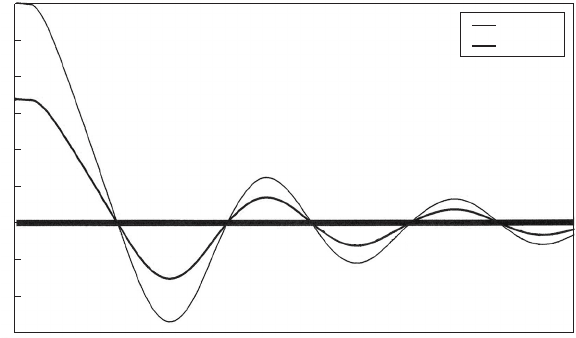
A flexible sleeve offering only a modest resistance will deform to a
greater extent under the influence of a reversed flow and differential
pressure than will a sleeve of much higher stiffness. Two systems are
considered to illustrate behaviour of the valve.
The first example concerns pumping failure within a short pipeline of
length 24 m and with a static head of 14 m. Pipe diameter was 400 mm.
A number of sleeve stiffnesses were considered, with the stiffness
defined by the maximum allowable differential pressure head which if
exceeded would invert the sleeve.
Enclosed volume within the valve upstream of the sleeve varied
substantially for two stiffnesses represented by maximum allowable
differential pressure heads of 20 mWG and 50 mWG. For the smaller
stiffness the sleeve volume was reduced to around 15 litres from an
initial 58 litres, while the stiffer sleeve reduced in volume to around
41 litres. For the lower sleeve stiffness of 20 mWG, reversed velocity
reaches almost 1.4 m/s after about 1 s as shown in Fig. 21.14. For
the stiffer sleeve, maximum reversed velocity was about 0.8 m/s
after 0.88 s.
Concerning head variations, Fig. 21.15 shows head upstream of the
pump and at inlet and outlet of the sleeve valve for the sleeve with
maximum allowable head of 20 m. Since outlet head is largely deter-
mined by a constant downstream head for this short pipeline system
there is little variation in peak head. At the valve inlet, minimum
head is lower for the 20 m sleeve than for the 50 m head sleeve, because
429
0.001
0.121
0.240
0.359
0.478
0.597
0.716
0.835
0.954
1.073
1.192
1.311
1.430
1.549
1.668
1.788
1.907
2.026
2.145
2.264
2.383
2.502
2.621
2.740
2.859
2.978
3.097
3.216
3.336
3.455
3.574
Velocity (m/s)
Time (s)
Series 1
Series 2
Red valve h
max
= 20
3
2.5
2
1.5
1
0.5
0
–0.5
–1
–1.5
Fig. 21.14. Velocity at a sleeve valve after pump trip
Check valve characteristics

of the higher rate of deceleration for the much larger reversed velocity
achieved in the 20 m sleeve.
If the reversed velocity is too great, a sleeve may be deformed to an
extent that it becomes inverted. Under these conditions the valve may
no longer remain fully closed and could allow some reversed flow to
continue. The rate of this continued reversed flow will depend upon
the inverted shape and stiffness of the sleeve. To illustrate conditions,
a simple system was considered. A uniform pipeline of length 980 m was
chosen which rises continuously from invert level þ0.0 mAD down-
stream of a pumping station to an elevation þ30.0 mAD at chainage
980 m. Discharge level was set at þ40 mAD. Pipe diameter was
400 mm. Suction well level was 4.0 mAD.
Pump start produced an eventual steady velocity of 1.9 m/s. Alterna-
tive sleeve stiffnesses were examined, ranging from 60 m to 100 m.
After pump trip, velocity at the pump and in the pipeline decelerates
and reverses after about 4 s as shown in Fig. 21.16 for a 60 m sleeve. An
initial reversed velocity is developed, reaching around 0.3 m/s. As the
sleeve deforms in an endeavour to mobilise sufficient strength to
decelerate the reversed flow, it becomes inverted after around 6 s as
shown in Fig. 21.17.
Figure 21.18 shows the head variations predicted for this event. After
trip, head downstream of the pump falls to 10.0 mAD and thereafter
increases gradually. After around 4 s the sleeve becomes closed and flow
430
Head (mAD)
Time (s)
Series 1
Series 2
Series 3
Red valve h
max
= 20
0.001
0.119
0.237
0.354
0.472
0.589
0.707
0.825
0.942
1.060
1.177
1.295
1.413
1.530
1.648
1.765
1.883
2.001
2.118
2.236
2.353
2.471
2.589
2.706
2.824
2.942
3.059
3.177
3.294
3.412
3.530
3.647
16
14
12
10
8
6
4
2
0
–2
Fig. 21.15. Head upstream and downst ream of a sleeve valve after pump trip
Pressure transients in water engineering

reverses, with head at the valve outlet rising steadily to a maximum
when the differential head across the valve reaches 60 m, at which
point the sleeve is considered to invert quite rapidly. Depending
upon the final shape of the inverted sleeve, reversed flow will continue
to proceed through the valve, producing a fall in valve outlet head.
Thereafter, conditions gradually approach a final steady reversed flow
condition within the system as a whole. The continuous reversed
431
Velocity (m/s)
Time (s)
Series 1
Series 2
Red valve – longer system h
max
= 60
0.005
0.353
0.701
1.049
1.396
1.744
2.092
2.440
2.788
3.136
3.484
3.832
4.180
4.526
4.875
5.223
5.571
5.919
6.267
6.615
6.963
7.311
7.659
8.007
8.354
8.702
9.050
9.398
9.746
10.094
10.442
2.5
2
1.5
1
0.5
0
–0.5
–1
Fig. 21.16. Velocity at failing sleeve valve
Volume (l)
Time
(
s
)
Series 1
Red valve – longer system: c
v
= 0.08, h
max
= 60.0
60
50
40
30
20
10
0
–10
–20
–30
4.091
4.170
4.248
4.327
4.405
4.483
4.562
4.640
4.719
4.797
4.875
4.954
5.032
5.111
5.189
5.267
5.346
5.424
5.503
5.581
5.659
5.738
5.816
5.895
5.973
6.051
6.130
6.208
6.287
6.365
6.443
6.522
Fig. 21.17. Downstream sleeve volume (computed)
Check valve characteristics
